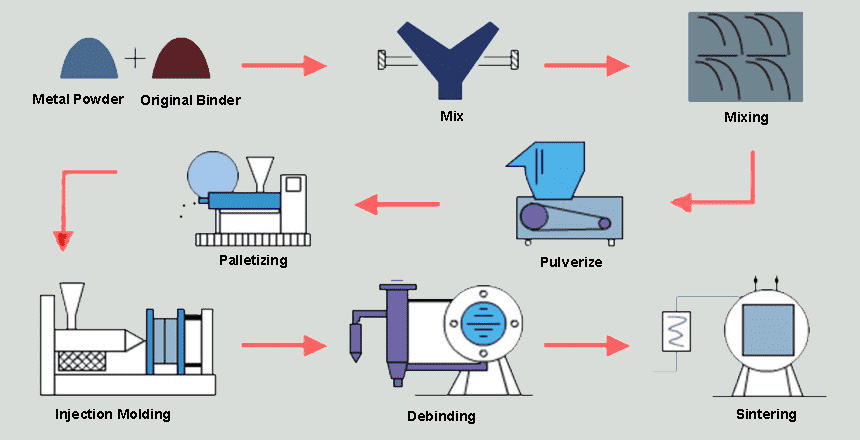The automotive, industrial, medical, electronics, and firearms industries have a huge demand for manufactured items that must be precise: complex geometries, fine surface finishes, and high tolerance performance. Products manufactured on metal die casting lines are likely to require additional machining steps, which add expense and waste, and investment casting can be a costly method.
One way to get the fine results needed more quickly, with less waste and ultimately lower costs, is metal injection molding, or MIM. The process ports to scratch The process provides the parts needed for a project from the ground up, without the need for extensive machining operations after initial production to achieve an end product with excellent surface finish, superior corrosion resistance and high strength. MIM can also provide amazing cost savings, up to 50% lower than machining or investment casting methods.
MIM is best viewed as a competitive alternative to machining, investment casting and powder metallurgy.
It offers the following advantages.
Goes beyond machining - reduces weight and allows the use of harder steels. Allows for the production of more complex individual parts, thus consolidating components to reduce costs and minimize machining steps.
Beyond investment casting - thinner walls, better surface finish, fewer secondary operations, smaller holes, higher yields, shorter lead times. shorter lead times.
Beyond powder metallurgy - more complex parts, thinner walls, parts consolidation, higher density, greater strength and better corrosion resistance. corrosion resistance.
MIM also delivers impressive cost savings, up to 50 percent lower than machining or investment casting methods.
What makes more sense to you?
MIM Part: $2.50 Each | CNC Part: $6.15 Each |
|---|---|
| $100,000 for 4 molds (average mold cost is $20,000) | $615,000 for machine, labor, etc. |
$150,000 for 100,000 pieces molded (4 parts 25,000 each) | 100,000 pieces machined (4 parts 25,000 each) |
| Year 1 $250,000 or $2.50 each | Year 1 $615,000 or $6.15 per part |
Let us see if we can save you $100,000’s or more per year.
Typical MIM Project Costs

Cost analysis is an important aspect of engineering metal parts design. One approach is to send out metal component designs and solicit responses from vendors. This usually results in a dramatic change in the estimated quote.
In MIM, the method of estimating metal component costs is to add up the costs accrued at each metal manufacturing step, starting with tooling fabrication and extending through secondary operations and final inspection. The increments are listed below:
Tooling Cost
Raw material cost (powder, binder, mixing or purchased raw materials)
Unit manufacturing costs (mixing, molding, debinding, sintering)
Secondary, finishing, inspection and packaging costs
Facility overhead burden
Profits, taxes, interest and risk aversion.
There are 3 factors that affect the Tooling Cost:
1, mold specifications: the larger the size of the injection mold, the higher the price is generally. For example, a small mold with a diameter of 10 cm may require only a few thousand dollars, while a large mold with a diameter of more than 50 cm may require tens or hundreds of thousands of investment.
2, material quality: commonly used mold materials are aluminum alloy, steel, copper and so on. Different material quality on the durability of the mold, stability, precision, processing difficulty, etc. will have an impact. Therefore, the price of high-quality mold materials will generally be higher.
3, production process: the production process of custom molds is more complex, including design, processing and commissioning and other aspects, requiring a series of professional equipment and technical personnel. Therefore, the injection mold price is also affected by the production process.
The MIM Process Sintering Cost
MIM with batch furnace charge can be from 1 kg to 300 kg. In the MIM production, the diameter of the sintering furnace can achieve 2-3m, a typical sintering period is 12-36h. On the other hand,adopted the push-rod furnace parts from the entrance to the export duration in 6 to 24h. Running costs will be lower, about $3 / kg, but flexible. Thus, the continuous sintering furnace is usually used similar products – such as table seat. Batch furnace sintering cost is very high, almost $6 / kg。Big parts need slow heating rate and causes the stove with high sintering cost。If need special sintering cycle or special stove, sintering cost would suddenly up to five times. Including part size and shape, material volume, the maximum temperature of the furnace, at the highest temperature of heat preservation time, atmosphere, heating rate, and special fixture or device used in sintering.
An example of sintering cost,a tool steel components of 6g adopt multi-stage vacuum sintering of the sintering cost is $0.10 / piece.But a 8g parts of stainless steel vacuum sintering cost is $0.05 / piece.A 25g sample of steel in the continuous sintering furnace under nitrogen atmosphere sintering costs only $0.02 / piece.
Costs depend on design factors such as part complexity, material selection, and part size. Procedures for estimating tooling costs are well established in plastic injection molding and provide a solid foundation for MIM.
Raw material costs are primarily determined by the alloy. The polymer used as the binder tends to be the low cost factor and the final price is virtually insensitive to the polymer formulation. Unit costs for forming, debinding, and sintering depend on the facility and the equipment installed; typically, these costs are based on hourly rates, so if each step is performed quickly, fewer costs accrue, which is an advantage for small, thin shapes.
Secondary operations can be performed in-house or by an external supplier; MIM has no advantage in this regard.
For the core manufacturing steps, unit operation calculations are developed for each step to accumulate total manufacturing costs. While there are recognized differences in all cost factors, including labor, it is interesting to note that labor is not the dominant factor; MIM has been successful in both high and low labor cost regions (typically less than 10% labor in the final part cost).











